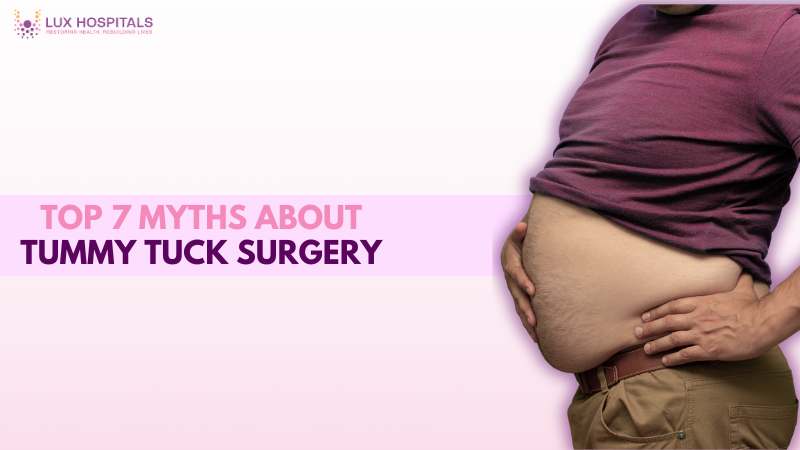Top 7 Myths About Tummy Tuck Surgery Debunked

Surgery to tuck the stomach is a standard cosmetic procedure. That removes extra skin from the belly to flatten it. And fat. Nevertheless, despite its widespread use, many myths and misunderstandings exist about the process intended to reduce excess fat and flatten the abdomen surrounding the skin. In this blog, we’ll debunk the top 7 myths about tummy tuck surgery, provide factual information, and address the most common questions people search for on Google. Whether you’re considering this procedure or just curious, it is essential to separate fact from fiction.
Common Myths About Tummy Tuck Surgery
Many people have misconceptions about tummy tuck surgery, often fueled by outdated information or hearsay. From believing it’s a weight loss solution to thinking only women undergo the procedure, these myths can prevent people from making informed choices. Below, we summarize the seven most common myths about tummy tuck surgery and explain the truth. Knowing these facts will boost your self-confidence. If you’re considering this transformative procedure,
1. Tummy Tuck Is a Weight Loss Procedure
Many believe that tummy tuck surgery is a quick fix for weight loss, but that’s not true.
- A stomach tuck does not replace losing weight or an obesity treatment.
- It is ideal for those already at a steady weight with extra skin. A stomach tuck does not replace losing weight or abdominal laxity.
- While a small amount of fat may be removed, the goal is body contouring, not weight reduction.
2. Only Women Get Tummy Tuck Surgery
Another common myth is that tummy tuck surgery is just for women, especially postpartum moms.
- Men also undergo tummy tuck surgery, particularly after massive weight loss that leaves loose skin.
- The procedure is popular among both genders looking for a firmer abdominal profile.
- The goals for men and women may differ slightly, but the technique and benefits remain similar.
3. Tummy Tuck Scars Are Always Horrible
Scarring is a concern, but assuming that tummy tuck scars are always unsightly is misleading.
- Most skilled surgeons place the incision low along the bikini line, making it easily concealable.
- With proper post-op care, scars fade significantly over time and may become barely noticeable.
- Scar treatments and laser therapy can further improve the appearance.
4. The Recovery from a Tummy Tuck Is Extremely Painful
While some discomfort is expected, thinking that tummy tuck recovery is unbearable is exaggerated.
- Modern pain management techniques and enhanced recovery protocols make healing more manageable.
- In a week or two, most people resume light activity and everyday routines in a month.
- Following your surgeon’s aftercare plan is essential for a smooth and comfortable recovery.
5. You Can’t Get Pregnant After a Tummy Tuck
One widespread misunderstanding is that tummy tucks may affect fertility or future pregnancies.
- A tummy tuck doesn’t interfere with a woman’s ability to conceive or carry a pregnancy.
- It is best to have the operation done after your most recent planned pregnancy, however.
- Future pregnancies won’t harm your health but may undo the cosmetic benefits of the surgery.
6. Tummy Tuck Results Are Permanent
Believing that tummy tuck results last forever without effort is unrealistic.
- The results can be long-lasting, but only if you live a healthy lifestyle and maintain a steady weight.
- Significant weight gain, pregnancy, or aging can affect the appearance of your abdomen.
- Maintaining your tummy tuck results requires regular exercise and a balanced diet. Regular exercise is key to preserving your tummy tuck outcomes.
7. Tummy Tuck Is Only for Vanity
Labeling tummy tuck surgery as purely cosmetic ignores its functional and emotional benefits.
- Beyond aesthetics, a tummy tuck can repair separated abdominal muscles (diastasis recti), improving core strength.
- It can also relieve back pain and correct posture in some patients.
- Many patients report enhanced self-esteem, improved mobility, and a better quality of life post-surgery.
Key Facts About Tummy Tuck Surgery
- Medical Name: Abdominoplasty
- Ideal Candidates: Non-smokers with stable weight, loose skin, or muscle separation
- Procedure Duration: 2–3 hours
- Recovery Time: Initial recovery 2–3 weeks; full recovery 6–8 weeks
- Cost Range: Varies by region and extent of surgery
- Risks: Infection, bleeding, numbness, scarring, fluid accumulation
Conclusion
Tummy tuck surgery is a safe and effective procedure when performed by a qualified surgeon, but it’s often misunderstood due to persistent myths. Knowing the facts helps set realistic expectations and empowers you to make informed decisions about your body. Whether you’re looking to restore your figure after pregnancy or tighten loose skin after weight loss, a tummy tuck can offer both physical and emotional benefits when approached with the right mindset and proper medical guidance.
Frequently Asked Questions
A tummy tuck is worth it for many people who want to eliminate sagging skin and restore abdominal firmness. It can boost confidence and improve appearance and posture. If you keep your weight steady, you get long-lasting results.
While recovery from a tummy tuck involves some discomfort, it's generally well-managed with pain medication and proper rest. Most patients describe it as soreness rather than severe pain. Newer techniques, like brainless tummy tucks, have also made recovery easier.
A tummy tuck can remove some stretch marks, especially those on the lower abdomen below the belly button. However, it won't remove all stretch marks if they are outside the excision area. The result is smoother skin in the treated zone.
The results of a tummy tuck can last many years if you keep a stable weight and lead a healthy lifestyle. Pregnancy or significant weight changes may affect your results. Regular exercise and a balanced diet can help maintain the outcome.
There is no fixed age for a tummy tuck, but most people undergo the procedure between 30 and 50. The best time is when you're done having children and your weight has been stable for at least six months. Good general health is more important than age.



















